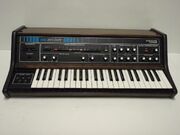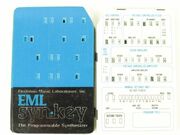
EML Synkey model 2001. Photo courtesy of audiofanzine.com.
A sort-of polyphonic analog synth produced by EML beginning in 1976. It was EML's last synth design before the company folded. It was notable for being one of the first synths to have a form of patch memory -- but in a bizarre form, which, combined with some other limitations of the synth, depressed sales and ultimately resulted in EML leaving the music business. EML advertised the synth as having 13 oscillators and being capable of playing 13 notes at once, but the truth was rather more complicated.
The first notable feature of the Synkey was the 13 pushbuttons on the front panel which allowed one-finger chords to be played, by selecting which intervals of the chromatic scale would sound when a key was pressed. These were labeled 'R' for "root" note (the note actually played), and then 12 buttons which selected intervals above the root note that would sound along with it. For example, pressing the 'R', 'm3', and '5' buttons would cause the synth to play a minor chord in the selected key when a key was pressed. The waveform of the root was continuously variable from pulse to sawtooth to triangle to square; the other 12 tones were fixed at a 30% duty cycle pulse wave. A white noise source could also be switched in.
The rest of the voice architecture was fairly conventional. There was a single multimode voltage controlled filter, capable of continuously variable response from lowpass to bandpass to high pass (a feature of most EML synths). ADSR envelope generators were provided for the voltage controlled amplifier (which was capable of being switched into a ring modulator mode) and the VCF; however, the decay knob controlled both the decay time and the release time. A single low frequency oscillator (referred to by EML as the "modulation oscillator") was provided, with five selections of waveforms. (Only three of the five could be selected from a patch; the other two could only be selected manually.)
An unusual feature of the 3-1/2, F-to-C keyboard, was that it had second touch. This could be used to activate pitch bend, modulation (vibrato), or the filter envelope for filter sweeps. The functions to be controlled were selected by switches at the left end of the keyboard. The second touch functions served as an alternate to conventional pitch or mod wheels, which EML had an aversion to for some reason.

EML Synkey patch punch cards, coutesy of Tone Tweakers
The most notable, and controversial, feature of the Synkey was its form of patch memory. This took the form of a plastic punch card, about the size of a credit card, which was inserted into a card reader slot on the panel to load a patch. The synth did not have the ability to "record" a patch onto a card; the user had to manually punch holes in the card, using a special punch supplied by EML, to build a patch. EML supplied cards pre-printed with legends and graphics showing the hole positions, and which holes needed to be punched to program which parameters. This presented a number of difficulties for the user. For instance, for a continuous parameter (e.g., filter cutoff), because there was no correlation between the knob indexing on the panel and the possible card values, the user had to experiment -- potentially wasting hard-to-get cards -- to find out what card values produced what results. The programming circuitry only had a resolution of three bits (meaning 8 possible values) for the continuous parameters, and it was common for a performer to manually build a patch, attempt to punch it onto a card, and then find that the optimum manually set value was "in between" two possible values that could be punched on the card. With each Synkey, EML supplied 25 pre-punched cards (essentially, factory patches) and 25 blank cards. In theory, performers could obtain more blank cards either from a dealer, or by buying them mail order from EML's office in Connecticut.
The Synkey turned out to be innovative in its concept, but the execution was lacking. Not all of the patch parameters could be programmed onto the card; several significant ones, such as the tone selection buttons and the LFO frequency, could not be programmed and had to be set manually after loading a patch from a card. (The card contained areas for punching holes for the tone selection and second-touch function selection, which had "DO NOT PUNCH" printed across them on the card. EML had intended for these parameters to be programmable, but they never finished this part of the design.) The instrument was not really polyphonic, despite EML's advertising; although the adventurous performer could play chord progressions after a fashion by playing a melody with one hand and punching at the interval buttons with the other, it wasn't like having a true polyphonic implementation. Further, the rest of the voice architecture was at best paraphonic; there was only one VCF and one VCA. And maybe the most serious one was that the 13 interval oscillators were really only one radio-frequency VCO, which was divided down to produce the tones. Performers claimed that this, combined with the fixed waveforms for all of the interval tones, cause ear-fatiguing static timbres.
The Synkey, although it was innovative, did not compare well to soon-to-be-introduced competition like the Prophet-5, which was truly polyphonic and had a far more usable form of patch memory. Two versions were offered: the original model, known as the 2001, and a lower-cost model that omitted the card reader and all of the programming circuity, called the 1500. Since many performers did not care for the card reader or punching patched, they actually preferred the 1500 and used old-fashioned methods of patch storage. It is unclear when production ceased; the 1500 may have remained in production until EML ceased all synth manufacturing, around 1983.